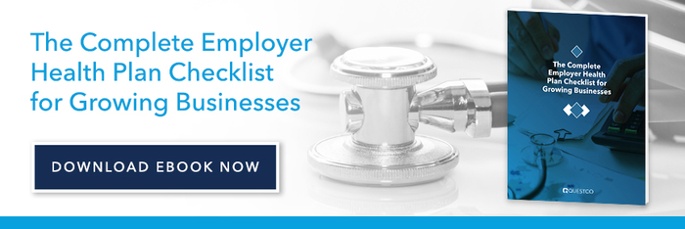Topic Employee Benefits
How a PEO Master Plan Contains Medical Costs

November 17, 2020 | By Jason Randall

Every year, tens of thousands of businesses partner with Professional Employer Organizations (PEOs) to help them cut costs, maximize HR administration, and reduce their risk burdens. In fact, NAPEO found that the average PEO provides a 27.2% ROI.
How are PEOs able to provide such an intense ROI?
After all, payroll processors — who only handle payroll — partnerships often result in negative ROIs. Even Administrative Services Organizations (ASOs), which handle many of the same services as PEOs, don't provide nearly that high of a return.
The answer is simple: benefits.
The cost savings on health benefits alone are massive for SMBs that team up with PEOs. Other types of outsourced HR partners are incapable of providing cost-savings on benefits. PEOs, on the other hand, give your business access to PEO master benefits plans.
So, how does it work?
How is it that PEOs can put businesses on a master healthcare plan while other outsourced HR partners can't? How do master plans save businesses money on health insurance?
Factors that Affect Your Group Health Insurance Premiums
Contrary to popular belief, insurance companies aren't completely in control of their premiums. The Affordable Care Act mandates that insurance companies can only take the following factors into account when adjusting premiums:
- The number of employees on the plan (i.e., risk pooling)
- The age of employees
- The location of your business
- Whether dependents are covered
- Tobacco use
- Plan category in the Healthcare Marketplace
Out of all of these factors, risk pooling is often the most impactful. The American Academy of Actuaries found that premium increases are primarily driven by the overall health of your group, the size of your group, and the size of past claims. ACA specifically prevents previous claims history from impacting initial premiums, so the bulk of this impact was measured by the number of employees in the group.
It's economies-of-scale; the more employees you have, the less risk your insurance company is taking. Roughly 5 percent of employees account for over half of healthcare spending. The more employees you have, the fewer you have in that five percent.
In other words, having ten employees often means that your insurance company will have 9 profitable employees and one costly employee. If you have 1,000 employees, the insurance company has 950 profitable employees and 50 costly employees. The math works in the insurance company's favor.
Small Businesses Have Higher Initial Premiums and Premium Increases
On average, small businesses pay 18% more for health insurance than their larger counterparts. Unfortunately, they also usually receive worse benefits. This is almost exclusively due to risk pooling.
The average small business has 10 employees. For health insurance providers, this is risky. The number of employees is too small to accurately calculate risk. In that business, there could be 7 employees that spend significant amounts of money on health insurance.
It may be that only 5 percent of employees make up the bulk of spending. But how does the insurance company know that you haven't hired 7 employees that exist in that 5 percent?
Now, let's say that you're a large organization with 5,000 employees. The health insurance company knows what to expect. Around 5 percent of your employees will be super-spenders. You have a large enough pool of employees to accurately calculate risk.
To put it simply, the larger the risk pool, the more predictable your health insurance spend is to insurance companies. Thus, they can charge lower and more stable premiums — since they can calculate their risk and reward.
PEO Health Insurance Master Plans
PEOs can help you increase your risk pool. When you partner with a PEO, you can join their master health insurance plans. These plans are created using employees from all of the businesses your PEO partners with. So, PEOs take hundreds of small businesses, pool their employees together, and uses all of those employees to negotiate for low-cost, high-value health insurance. That means Fortune 500 benefits at Fortune 500 prices — regardless of your size.
PEOs are the only outsourced HR partner that can create these master plans. That's due to an incredibly powerful and unique HR tool that PEOs have at their disposal — co-employment.
The Co-Employment Advantage
Co-employment is a dynamic legal tool that allows PEOs to secure low-cost benefits, tackle payroll, and reduce your compliance burdens. At its core, co-employment splits the responsibilities of an employer between two parties. However, it's important to note that co-employment does not result in a loss-of-control for the business owner.
Your PEO can't hire, fire, or discipline your employees, and you still have total control of your day-to-day business decisions. Instead, co-employment allows your PEO to pool workers for benefits and share risk with you.
Your PEO uses co-employment to accomplish a variety of benefit-bearing tasks, including:
- Collecting, depositing, and reporting on local, state, and federal employment taxes
- Remitting wages and withholdings
- Issuing W-2 forms
- Risk pooling for master benefits plans
There's a larger, less tangible benefit to co-employment. Your PEO shares risk with you. If they file your payroll taxes and there is a problem, they are partially liable. The same is not true for any other form of HR outsourcing.
PEOs Help You Contain Medical Costs
Small businesses often pay significantly more for benefits than their larger competitors. That's a problem. 83% of employees admit that health insurance is a "very important" factor when considering staying at a job or switching jobs. Health insurance alone is the reason that over 50% of employees stay at their jobs. As a small business, you have to control medical costs if you want access to top talent in the marketplace. In other words, your competitive agility relies on reducing your medical costs.
That’s where the power of a PEO’s master plan comes into play; your PEO gives you access to Fortune 500 benefits at Fortune 500 prices.
.jpg)
Jason Randall
Jason L. Randall is the CEO of The Questco Companies. He regularly speaks on topics related to strategy, growth, and organizational performance.




